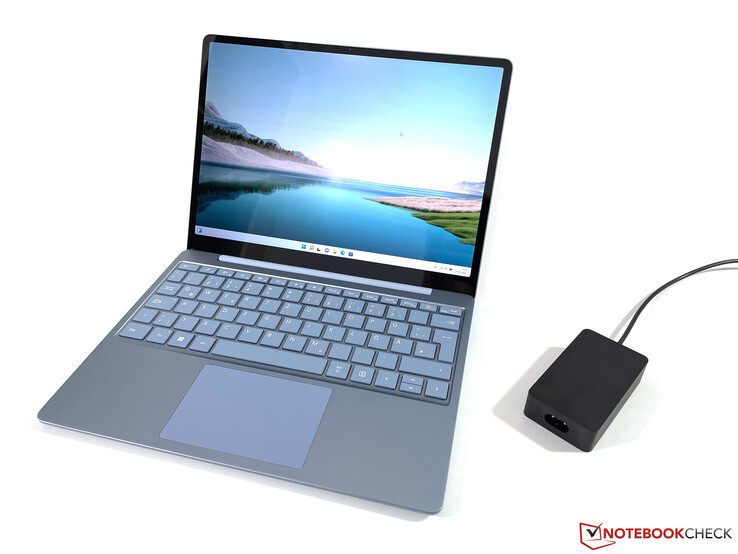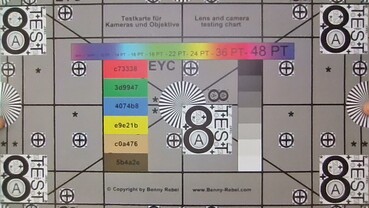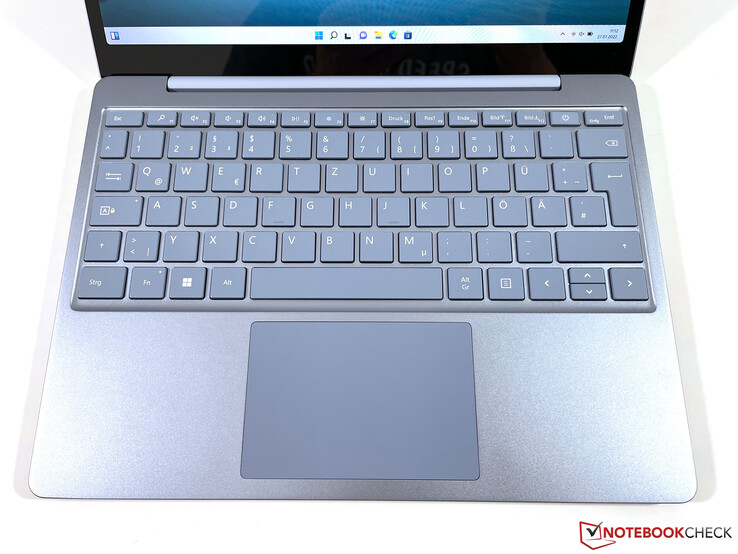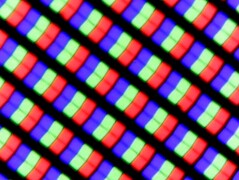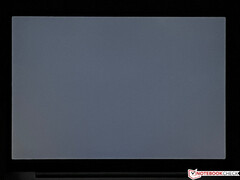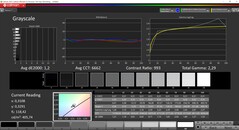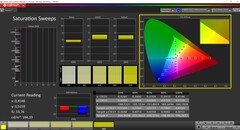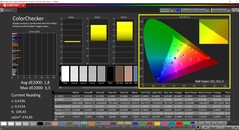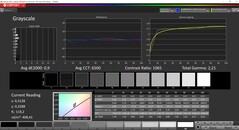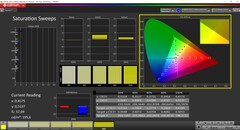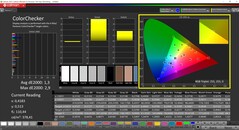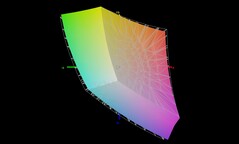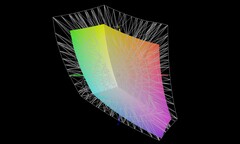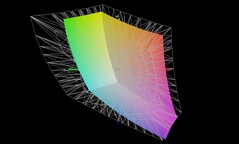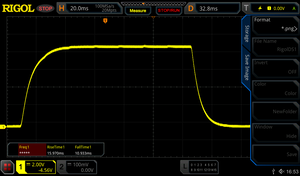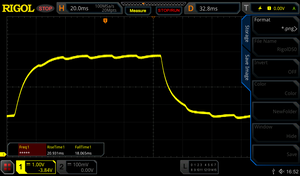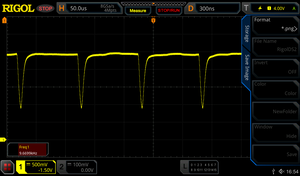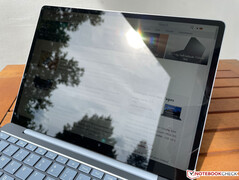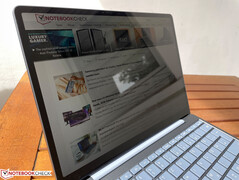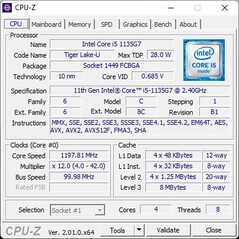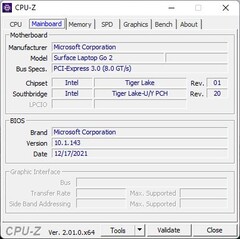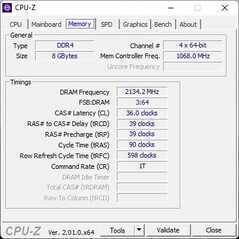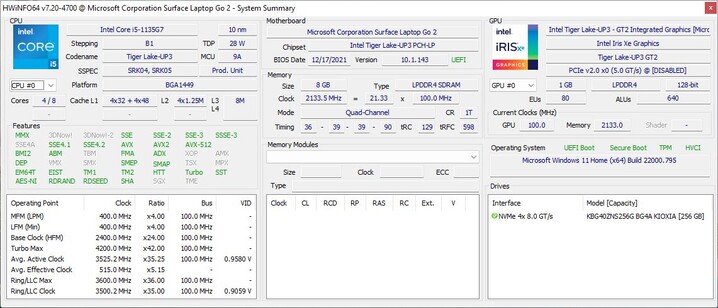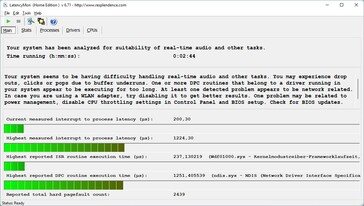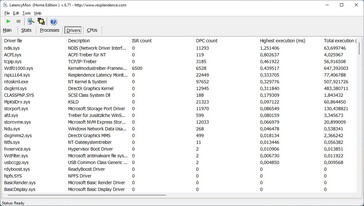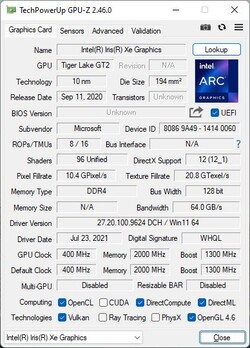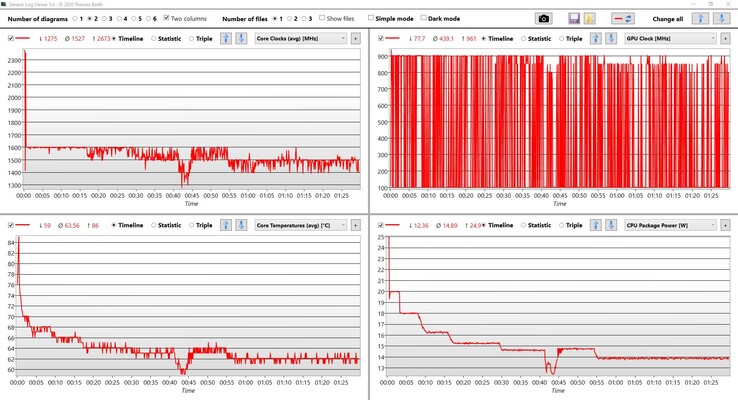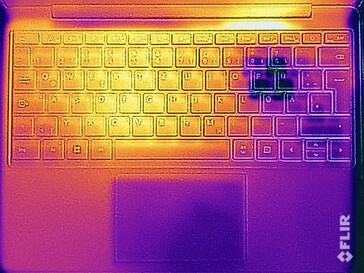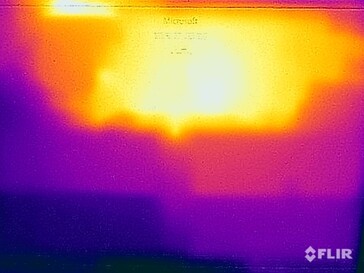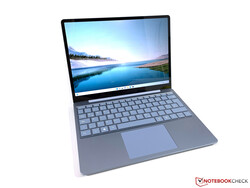Análisis del Microsoft Surface Laptop Go 2: compañero compacto con hardware antiguo

Con el Surface Laptop Go, Microsoft ofrece un dispositivo compacto de entrada al mundo de los portátiles Surface, y la segunda generación recibe un procesador Core i5 más rápido de la generación Intel Tiger Lake. Sin embargo, nada ha cambiado en el diseño básico del portátil. El precio del nuevo Surface Laptop Go 2 parte oficialmente de unos 600 euros (~602 dólares) con el Core i5-1135G7, 4 GB de RAM y un SSD de 128 GB, pero este modelo sólo está disponible actualmente en Microsoft directamente.
Nuestra unidad de pruebas es el modelo más caro con un precio de 869 euros, ofreciendo 8 GB de RAM y un SSD PCIe de 256 GB. En este punto, Microsoft ya ha bajado los precios, y nuestro modelo está ahora disponible por 679 Euros directamente en Microsoft.
Posibles contendientes en la comparación
Valoración | Fecha | Modelo | Peso | Altura | Tamaño | Resolución | Precio |
|---|---|---|---|---|---|---|---|
| 83.3 % v7 (old) | 08/2022 | Microsoft Surface Laptop Go 2 Core i5 i5-1135G7, Iris Xe G7 80EUs | 1.1 kg | 16 mm | 12.40" | 1536x1024 | |
| 87.7 % v7 (old) | 05/2021 | Dell XPS 13 9305 Core i5 FHD i5-1135G7, Iris Xe G7 80EUs | 1.2 kg | 16 mm | 13.30" | 1920x1080 | |
| 91.1 % v7 (old) | 12/2020 | Apple MacBook Air 2020 M1 Entry M1, M1 7-Core GPU | 1.3 kg | 16.1 mm | 13.30" | 2560x1600 | |
| 86.3 % v7 (old) | 04/2022 | VAIO SX12 VJS124X1011P i5-1155G7, Iris Xe G7 80EUs | 892 g | 17.8 mm | 12.50" | 1920x1080 | |
| 84.6 % v7 (old) | 10/2020 | Microsoft Surface Laptop Go Core i5 i5-1035G1, UHD Graphics G1 (Ice Lake 32 EU) | 1.1 kg | 15.69 mm | 12.40" | 1536x1024 |
Maletín y equipo
Microsoft mantuvo el diseño de la carcasa del Surface Laptop Gosin realizar ningún cambio. Sigue siendo un producto de alta calidad que puede competir fácilmente con competidores bastante más caros. Tampoco hay diferencias con los modelos Surface más caros en este sentido. La estabilidad de la carcasa metálica (tapa de aluminio y unidad de base hecha tanto de aluminio como de plástico) es muy buena, sólo la bisagra podría haber resultado algo más rígida, ya que no puede evitar por completo algunos tambaleos. El ángulo máximo de apertura es de 135 grados.
El color de nuestra unidad de prueba se llama Ice Blue y se ve bien. Como alternativa, también están disponibles los colores Platin, Sage y Sandstone. Nos gusta la impresión visual del dispositivo compacto con su unidad de base cónica. Sólo los biseles de la pantalla (particularmente debajo de la pantalla) parecen un poco anchos. Pero en general, el Surface Laptop Go 2 sigue siendo un dispositivo atractivo. Sin embargo, sigue siendo una gran desventaja el hecho de que sea prácticamente imposible (por diseño) que el usuario final pueda realizar cualquier tipo de mantenimiento.
Top 10 Análisis
» Top 10 Portátiles Multimedia
» Top 10 Portátiles de Juego
» Top 10 Portátiles de Juego ligeros
» Top 10 Portátiles Asequibles de Oficina/Empresa
» Top 10 Portátiles de Juego Ligeros
» Top 10 Portátiles de Oficina/Empresa Premium
» Top 10 Estaciones de Trabajo
» Top 10 Subportátiles
» Top 10 Ultrabooks
» Top 10 Convertibles
» Top 10 Tablets
» Top 10 Tablets Windows
» Top 10 Tablets de menos de 250 Euros
» Top 10 Phablets (>5.5")
» Top 10 Smartphones
» Top 10 Smartphones (≤5")
» Top 10 Smartphones de menos de 300 Euros
» Top 10 Smartphones de menos de 120 Euros
» Top 10 Portátiles de menos de 1000 Euros
» Top 10 Portátiles de menos de 500 Euros
» Top 10 Portátiles de menos de 300 Euros
» Los Mejores Displays de Portátiles Analizados por Notebookcheck
Tampoco hay cambios en las conexiones, y Microsoft sigue utilizando el poco práctico Surface Connector. Por otro lado, esto también permite usar otros accesorios. También puedes cargar el Surface Laptop Go 2 por USB-C, y también es posible conectar un monitor externo de ese modo. Aunque tienes que vivir sin Thunderbolt o estándares rápidos, puedes beneficiarte de la conexión USB-A normal en el uso diario. La webcam sigue siendo un sensor 720p, cuya calidad apenas convence.
En cuanto al módulo WLAN, Microsoft sigue utilizando la tarjeta AX201 de Intel. Soporta redes Wi-Fi-6 y alcanza tasas de transferencia muy altas y estables en la prueba con nuestro router de referencia Asus. No encontramos ningún problema con ella en nuestro periodo de pruebas. También soporta Bluetooth 5.1.
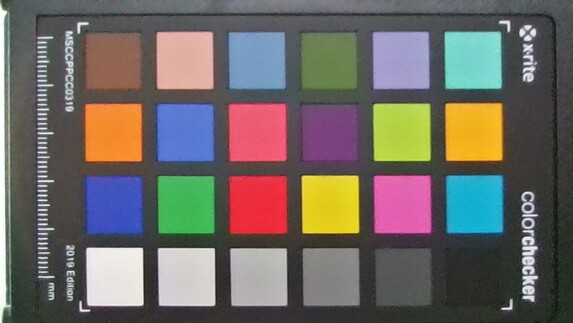
Dispositivos de entrada - Microsoft prescinde de la iluminación del teclado
El teclado del Surface Laptop Go 2 ofrece una buena experiencia de escritura, permitiendo además escribir textos más largos sin problemas. Como ya es el caso, no hay diferencias notables con los portátiles Surface más caros. Sin embargo, lo que sí notarás es la falta de iluminación del teclado, lo que representa un claro punto negativo teniendo en cuenta el MSRP original.
El ClickPad funciona perfectamente, y en contraste con muchos otros portátiles, los sonidos de clicks tampoco son demasiado fuertes. Como alternativa, también puedes usar la pantalla táctil capacitiva para las entradas, que también funciona sin problemas.
Pantalla - Surface Laptop Go con pantalla táctil IPS 3:2
La pantalla de 12,4 pulgadas con el formato 3:2 ofrece algunas ventajas en cuanto a productividad, ya que tienes más espacio vertical para trabajar. Sin embargo, aquellos a los que les gusta ver películas o series tienen que vivir con algunas barras negras más grandes en la parte superior e inferior, en comparación con las pantallas 16:9 o 16:10. La resolución del panel IPS sigue siendo relativamente baja, 1.536 x 1.024 píxeles (148 DPI), pero la impresión subjetiva de la imagen sigue siendo buena en términos de nitidez. Gracias a un sensor de luminosidad, el brillo del panel puede ajustarse automáticamente.
En nuestras mediciones con el software profesional CalMAN (X-Rite i1 Pro 2), el brillo medio es de 400 cd/m², es decir, unos 50 cd/m² más brillante que el predecesor, aunque se utilice el mismo panel. Por otro lado, el valor de negro y la relación de contraste resultante resultan peores, y el nuevo Surface Laptop Go 2 apenas alcanza un contraste de 1000:1. A niveles de brillo del 50% o inferiores, medimos parpadeos PWM a una frecuencia de 9.7 kHz, pero esto no debería dar problemas. Los tiempos de respuesta son discretos, y los ángulos de visión del panel IPS también son buenos.
| |||||||||||||||||||||||||
iluminación: 95 %
Brillo con batería: 406 cd/m²
Contraste: 990:1 (Negro: 0.41 cd/m²)
ΔE ColorChecker Calman: 1.8 | ∀{0.5-29.43 Ø4.78}
calibrated: 1.3
ΔE Greyscale Calman: 1.2 | ∀{0.09-98 Ø5}
65% AdobeRGB 1998 (Argyll 3D)
93.8% sRGB (Argyll 3D)
63.6% Display P3 (Argyll 3D)
Gamma: 2.29
CCT: 6662 K
| Microsoft Surface Laptop Go 2 Core i5 LP125WX112403, IPS, 1536x1024, 12.4" | Dell XPS 13 9305 Core i5 FHD Sharp SHP14AE, IPS, 1920x1080, 13.3" | Apple MacBook Air 2020 M1 Entry IPS, 2560x1600, 13.3" | VAIO SX12 VJS124X1011P Chi Mei N125HCG-GQ1, IPS, 1920x1080, 12.5" | Microsoft Surface Laptop Go Core i5 LG Philips LP125WX112403, IPS, 1536x1024, 12.4" | |
|---|---|---|---|---|---|
| Display | 4% | 31% | 6% | 1% | |
| Display P3 Coverage (%) | 63.6 | 66.3 4% | 98.6 55% | 67.6 6% | 64.4 1% |
| sRGB Coverage (%) | 93.8 | 97.1 4% | 100 7% | 99.2 6% | 94.6 1% |
| AdobeRGB 1998 Coverage (%) | 65 | 67.1 3% | 85.9 32% | 69.4 7% | 65.7 1% |
| Response Times | -21% | 12% | -55% | 1% | |
| Response Time Grey 50% / Grey 80% * (ms) | 39 ? | 55 ? -41% | 31 ? 21% | 60 ? -54% | 34.8 ? 11% |
| Response Time Black / White * (ms) | 26.9 ? | 27 ? -0% | 26.1 ? 3% | 41.6 ? -55% | 29.2 ? -9% |
| PWM Frequency (Hz) | 9700 ? | 996 ? | 118000 ? | 21930 ? | |
| Screen | -12% | 7% | 23% | 5% | |
| Brightness middle (cd/m²) | 406 | 486 20% | 417 3% | 384.8 -5% | 354.3 -13% |
| Brightness (cd/m²) | 401 | 446 11% | 395 -1% | 361 -10% | 353 -12% |
| Brightness Distribution (%) | 95 | 77 -19% | 91 -4% | 90 -5% | 95 0% |
| Black Level * (cd/m²) | 0.41 | 0.4 2% | 0.39 5% | 0.18 56% | 0.29 29% |
| Contrast (:1) | 990 | 1215 23% | 1069 8% | 2138 116% | 1222 23% |
| Colorchecker dE 2000 * | 1.8 | 2.54 -41% | 1.12 38% | 1.54 14% | 1.41 22% |
| Colorchecker dE 2000 max. * | 3.3 | 4.34 -32% | 2.71 18% | 2.95 11% | 2.96 10% |
| Colorchecker dE 2000 calibrated * | 1.3 | 1.04 20% | 0.77 41% | 0.96 26% | 1.44 -11% |
| Greyscale dE 2000 * | 1.2 | 2.34 -95% | 1.7 -42% | 1.2 -0% | 1.2 -0% |
| Gamma | 2.29 96% | 2.28 96% | 2207 0% | 2.1 105% | 2.26 97% |
| CCT | 6662 98% | 6864 95% | 6870 95% | 6419 101% | 6600 98% |
| Color Space (Percent of AdobeRGB 1998) (%) | 62 | 60.2 | |||
| Color Space (Percent of sRGB) (%) | 97 | 94.4 | |||
| Media total (Programa/Opciones) | -10% /
-10% | 17% /
13% | -9% /
8% | 2% /
4% |
* ... más pequeño es mejor
La precisión del color ya es muy buena en el estado de entrega, y el display tampoco tiene tinte de color. Con nuestro propio calibrado (perfil disponible para su descarga gratuita en el enlace anterior), las desviaciones pueden incluso reducirse ligeramente, aunque no es realmente necesario. Por desgracia, el panel no cubre completamente ni siquiera el pequeño espacio de color sRGB.
Tiempos de respuesta del display
| ↔ Tiempo de respuesta de Negro a Blanco | ||
|---|---|---|
| 26.9 ms ... subida ↗ y bajada ↘ combinada | ↗ 16 ms subida | |
| ↘ 10.9 ms bajada | ||
| La pantalla mostró tiempos de respuesta relativamente lentos en nuestros tests pero podría ser demasiado lenta para los jugones. En comparación, todos los dispositivos de prueba van de ##min### (mínimo) a 240 (máximo) ms. » 66 % de todos los dispositivos son mejores. Eso quiere decir que el tiempo de respuesta es peor que la media (20.2 ms) de todos los dispositivos testados. | ||
| ↔ Tiempo de respuesta 50% Gris a 80% Gris | ||
| 39 ms ... subida ↗ y bajada ↘ combinada | ↗ 20.9 ms subida | |
| ↘ 18.1 ms bajada | ||
| La pantalla mostró tiempos de respuesta lentos en nuestros tests y podría ser demasiado lenta para los jugones. En comparación, todos los dispositivos de prueba van de ##min### (mínimo) a 636 (máximo) ms. » 58 % de todos los dispositivos son mejores. Eso quiere decir que el tiempo de respuesta es peor que la media (31.6 ms) de todos los dispositivos testados. | ||
Parpadeo de Pantalla / PWM (Pulse-Width Modulation)
| Parpadeo de Pantalla / PWM detectado | 9700 Hz | ≤ 50 % de brillo | |
La retroiluminación del display parpadea a 9700 Hz (seguramente usa PWM - Pulse-Width Modulation) a un brillo del 50 % e inferior. Sobre este nivel de brillo no debería darse parpadeo / PWM. La frecuencia de 9700 Hz es bastante alta, por lo que la mayoría de gente sensible al parpadeo no debería ver parpadeo o tener fatiga visual. Comparación: 53 % de todos los dispositivos testados no usaron PWM para atenuar el display. Si se usó, medimos una media de 8111 (mínimo: 5 - máxmo: 343500) Hz. | |||
Rendimiento - Intel Tiger Lake Core i5
Todos los modelos del Surface Laptop Go 2 están equipados con el Intel Core i5-1135G7. Las únicas diferencias están en la memoria de trabajo y la capacidad del SSD. Teniendo en cuenta la usabilidad en años futuros, no recomendaríamos el modelo básico con sólo 4 GB de RAM. La memoria de trabajo está soldada y no se puede actualizar.
Condiciones de la prueba
Microsoft no implementa ningún perfil de rendimiento adicional. Para los siguientes benchmarks y mediciones, usamos el modo Windows de Mejor Rend imiento. Sin embargo, particularmente para tareas sencillas, también puedes mantener el preajuste Recomendado sin ninguna preocupación, ya que el rendimiento está a un nivel bastante bajo en general y los ventiladores permanecerán entonces ligeramente más silenciosos (pero más sobre esto más adelante).
Procesador - Core i5-1135G7
ElCore i5-1135G7 es un chip de cuatro núcleos de la antigua generación de Intel Tiger Lake, por lo que ya no es realmente actual. Además, Microsoft es bastante conservador en cuanto a los límites de TDP, ya que el chip puede consumir un máximo de 25 vatios, antes de nivelarse rápidamente en 15 vatios. En consecuencia, el rendimiento del procesador tampoco es especialmente bueno. Aunque hay una ventaja de alrededor del 30% en comparación con el procesador, el Surface Laptop Go 2 sigue sin ser adecuado para tareas exigentes. Pero al menos, el rendimiento no se reduce más en el funcionamiento de la batería. Para más pruebas de CPU, le remitimos a nuestra sección de tecnología.
Cinebench R15 Multi Constant Load Test
Cinebench R23: Multi Core | Single Core
Cinebench R20: CPU (Multi Core) | CPU (Single Core)
Cinebench R15: CPU Multi 64Bit | CPU Single 64Bit
Blender: v2.79 BMW27 CPU
7-Zip 18.03: 7z b 4 | 7z b 4 -mmt1
Geekbench 5.5: Multi-Core | Single-Core
HWBOT x265 Benchmark v2.2: 4k Preset
LibreOffice : 20 Documents To PDF
R Benchmark 2.5: Overall mean
| CPU Performance rating | |
| Media de la clase Subnotebook | |
| Apple MacBook Air 2020 M1 Entry -1! | |
| VAIO SX12 VJS124X1011P | |
| Medio Intel Core i5-1135G7 | |
| Dell XPS 13 9305 Core i5 FHD -2! | |
| Microsoft Surface Laptop Go 2 Core i5 | |
| Microsoft Surface Laptop Go Core i5 -2! | |
| Cinebench R23 / Multi Core | |
| Media de la clase Subnotebook (1555 - 21812, n=76, últimos 2 años) | |
| Apple MacBook Air 2020 M1 Entry | |
| VAIO SX12 VJS124X1011P | |
| Dell XPS 13 9305 Core i5 FHD | |
| Medio Intel Core i5-1135G7 (2786 - 6136, n=55) | |
| Microsoft Surface Laptop Go 2 Core i5 | |
| Cinebench R23 / Single Core | |
| Media de la clase Subnotebook (358 - 2165, n=77, últimos 2 años) | |
| Apple MacBook Air 2020 M1 Entry | |
| VAIO SX12 VJS124X1011P | |
| Medio Intel Core i5-1135G7 (1062 - 1373, n=53) | |
| Microsoft Surface Laptop Go 2 Core i5 | |
| Dell XPS 13 9305 Core i5 FHD | |
| Cinebench R20 / CPU (Multi Core) | |
| Media de la clase Subnotebook (579 - 8541, n=70, últimos 2 años) | |
| VAIO SX12 VJS124X1011P | |
| Apple MacBook Air 2020 M1 Entry | |
| Dell XPS 13 9305 Core i5 FHD | |
| Medio Intel Core i5-1135G7 (979 - 2382, n=62) | |
| Microsoft Surface Laptop Go 2 Core i5 | |
| Microsoft Surface Laptop Go Core i5 | |
| Cinebench R20 / CPU (Single Core) | |
| Media de la clase Subnotebook (128 - 826, n=70, últimos 2 años) | |
| VAIO SX12 VJS124X1011P | |
| Medio Intel Core i5-1135G7 (375 - 527, n=62) | |
| Microsoft Surface Laptop Go 2 Core i5 | |
| Dell XPS 13 9305 Core i5 FHD | |
| Microsoft Surface Laptop Go Core i5 | |
| Apple MacBook Air 2020 M1 Entry | |
| Cinebench R15 / CPU Multi 64Bit | |
| Media de la clase Subnotebook (327 - 3345, n=70, últimos 2 años) | |
| Apple MacBook Air 2020 M1 Entry | |
| VAIO SX12 VJS124X1011P | |
| Medio Intel Core i5-1135G7 (431 - 941, n=65) | |
| Dell XPS 13 9305 Core i5 FHD | |
| Microsoft Surface Laptop Go 2 Core i5 | |
| Microsoft Surface Laptop Go Core i5 | |
| Cinebench R15 / CPU Single 64Bit | |
| Media de la clase Subnotebook (72.4 - 322, n=70, últimos 2 años) | |
| VAIO SX12 VJS124X1011P | |
| Apple MacBook Air 2020 M1 Entry | |
| Medio Intel Core i5-1135G7 (141.4 - 205, n=61) | |
| Microsoft Surface Laptop Go 2 Core i5 | |
| Microsoft Surface Laptop Go Core i5 | |
| Blender / v2.79 BMW27 CPU | |
| Microsoft Surface Laptop Go Core i5 | |
| Microsoft Surface Laptop Go 2 Core i5 | |
| Apple MacBook Air 2020 M1 Entry | |
| Medio Intel Core i5-1135G7 (499 - 1044, n=60) | |
| Dell XPS 13 9305 Core i5 FHD | |
| VAIO SX12 VJS124X1011P | |
| Media de la clase Subnotebook (159 - 2271, n=73, últimos 2 años) | |
| 7-Zip 18.03 / 7z b 4 | |
| Media de la clase Subnotebook (11668 - 77867, n=70, últimos 2 años) | |
| Apple MacBook Air 2020 M1 Entry | |
| VAIO SX12 VJS124X1011P | |
| Dell XPS 13 9305 Core i5 FHD | |
| Medio Intel Core i5-1135G7 (14745 - 24873, n=62) | |
| Microsoft Surface Laptop Go 2 Core i5 | |
| Microsoft Surface Laptop Go Core i5 | |
| 7-Zip 18.03 / 7z b 4 -mmt1 | |
| Media de la clase Subnotebook (2643 - 6442, n=72, últimos 2 años) | |
| Apple MacBook Air 2020 M1 Entry | |
| VAIO SX12 VJS124X1011P | |
| Medio Intel Core i5-1135G7 (3924 - 4921, n=62) | |
| Microsoft Surface Laptop Go 2 Core i5 | |
| Dell XPS 13 9305 Core i5 FHD | |
| Microsoft Surface Laptop Go Core i5 | |
| Geekbench 5.5 / Multi-Core | |
| Media de la clase Subnotebook (2557 - 17218, n=65, últimos 2 años) | |
| Apple MacBook Air 2020 M1 Entry | |
| VAIO SX12 VJS124X1011P | |
| Dell XPS 13 9305 Core i5 FHD | |
| Medio Intel Core i5-1135G7 (3475 - 5472, n=58) | |
| Microsoft Surface Laptop Go 2 Core i5 | |
| Microsoft Surface Laptop Go Core i5 | |
| Geekbench 5.5 / Single-Core | |
| Media de la clase Subnotebook (726 - 2350, n=65, últimos 2 años) | |
| Apple MacBook Air 2020 M1 Entry | |
| VAIO SX12 VJS124X1011P | |
| Medio Intel Core i5-1135G7 (1147 - 1428, n=58) | |
| Dell XPS 13 9305 Core i5 FHD | |
| Microsoft Surface Laptop Go 2 Core i5 | |
| Microsoft Surface Laptop Go Core i5 | |
| HWBOT x265 Benchmark v2.2 / 4k Preset | |
| Media de la clase Subnotebook (0.97 - 25.1, n=70, últimos 2 años) | |
| VAIO SX12 VJS124X1011P | |
| Medio Intel Core i5-1135G7 (3.57 - 7.6, n=57) | |
| Microsoft Surface Laptop Go 2 Core i5 | |
| Microsoft Surface Laptop Go Core i5 | |
| LibreOffice / 20 Documents To PDF | |
| Microsoft Surface Laptop Go Core i5 | |
| Dell XPS 13 9305 Core i5 FHD | |
| Microsoft Surface Laptop Go 2 Core i5 | |
| Media de la clase Subnotebook (38.5 - 220, n=69, últimos 2 años) | |
| Medio Intel Core i5-1135G7 (44.2 - 62.9, n=60) | |
| VAIO SX12 VJS124X1011P | |
| Apple MacBook Air 2020 M1 Entry | |
| R Benchmark 2.5 / Overall mean | |
| Microsoft Surface Laptop Go Core i5 | |
| Apple MacBook Air 2020 M1 Entry | |
| Microsoft Surface Laptop Go 2 Core i5 | |
| Dell XPS 13 9305 Core i5 FHD | |
| Medio Intel Core i5-1135G7 (0.619 - 0.727, n=59) | |
| VAIO SX12 VJS124X1011P | |
| Media de la clase Subnotebook (0.403 - 1.456, n=71, últimos 2 años) | |
* ... más pequeño es mejor
AIDA64: FP32 Ray-Trace | FPU Julia | CPU SHA3 | CPU Queen | FPU SinJulia | FPU Mandel | CPU AES | CPU ZLib | FP64 Ray-Trace | CPU PhotoWorxx
| Performance rating | |
| Media de la clase Subnotebook | |
| VAIO SX12 VJS124X1011P | |
| Medio Intel Core i5-1135G7 | |
| Microsoft Surface Laptop Go 2 Core i5 | |
| AIDA64 / FP32 Ray-Trace | |
| Media de la clase Subnotebook (1135 - 32888, n=69, últimos 2 años) | |
| VAIO SX12 VJS124X1011P | |
| Medio Intel Core i5-1135G7 (4313 - 7952, n=45) | |
| Microsoft Surface Laptop Go 2 Core i5 | |
| AIDA64 / FPU Julia | |
| Media de la clase Subnotebook (5218 - 123315, n=69, últimos 2 años) | |
| VAIO SX12 VJS124X1011P | |
| Medio Intel Core i5-1135G7 (19402 - 32283, n=45) | |
| Microsoft Surface Laptop Go 2 Core i5 | |
| AIDA64 / CPU SHA3 | |
| Media de la clase Subnotebook (444 - 5287, n=69, últimos 2 años) | |
| VAIO SX12 VJS124X1011P | |
| Medio Intel Core i5-1135G7 (1316 - 2172, n=45) | |
| Microsoft Surface Laptop Go 2 Core i5 | |
| AIDA64 / CPU Queen | |
| Media de la clase Subnotebook (10579 - 115682, n=69, últimos 2 años) | |
| VAIO SX12 VJS124X1011P | |
| Medio Intel Core i5-1135G7 (39000 - 46951, n=45) | |
| Microsoft Surface Laptop Go 2 Core i5 | |
| AIDA64 / FPU SinJulia | |
| Media de la clase Subnotebook (744 - 18418, n=69, últimos 2 años) | |
| VAIO SX12 VJS124X1011P | |
| Medio Intel Core i5-1135G7 (3497 - 4445, n=45) | |
| Microsoft Surface Laptop Go 2 Core i5 | |
| AIDA64 / FPU Mandel | |
| Media de la clase Subnotebook (3341 - 65433, n=69, últimos 2 años) | |
| VAIO SX12 VJS124X1011P | |
| Medio Intel Core i5-1135G7 (12569 - 19635, n=45) | |
| Microsoft Surface Laptop Go 2 Core i5 | |
| AIDA64 / CPU AES | |
| VAIO SX12 VJS124X1011P | |
| Medio Intel Core i5-1135G7 (28988 - 67977, n=45) | |
| Media de la clase Subnotebook (638 - 161430, n=69, últimos 2 años) | |
| Microsoft Surface Laptop Go 2 Core i5 | |
| AIDA64 / CPU ZLib | |
| Media de la clase Subnotebook (164.9 - 1379, n=69, últimos 2 años) | |
| VAIO SX12 VJS124X1011P | |
| Medio Intel Core i5-1135G7 (265 - 373, n=51) | |
| Microsoft Surface Laptop Go 2 Core i5 | |
| AIDA64 / FP64 Ray-Trace | |
| Media de la clase Subnotebook (610 - 17495, n=69, últimos 2 años) | |
| VAIO SX12 VJS124X1011P | |
| Medio Intel Core i5-1135G7 (2226 - 4291, n=45) | |
| Microsoft Surface Laptop Go 2 Core i5 | |
| AIDA64 / CPU PhotoWorxx | |
| Media de la clase Subnotebook (6569 - 64588, n=69, últimos 2 años) | |
| VAIO SX12 VJS124X1011P | |
| Microsoft Surface Laptop Go 2 Core i5 | |
| Medio Intel Core i5-1135G7 (9004 - 45366, n=45) | |
Rendimiento del sistema
En la práctica, la impresión del rendimiento es decente, y gracias al SSD, no hay problemas con tiempos de carga más largos o tartamudeos en el funcionamiento diario. Sin embargo, nuestra unidad de pruebas suele ser superada por los competidores en los benchmarks. Pero para las tareas habituales, como la introducción de texto, la navegación por Internet y la transmisión de vídeos, el rendimiento es fácilmente suficiente.
CrossMark: Overall | Productivity | Creativity | Responsiveness
| PCMark 10 / Score | |
| Media de la clase Subnotebook (4920 - 8424, n=56, últimos 2 años) | |
| VAIO SX12 VJS124X1011P | |
| Dell XPS 13 9305 Core i5 FHD | |
| Medio Intel Core i5-1135G7, Intel Iris Xe Graphics G7 80EUs (4026 - 4952, n=53) | |
| Microsoft Surface Laptop Go 2 Core i5 | |
| Microsoft Surface Laptop Go Core i5 | |
| PCMark 10 / Essentials | |
| Media de la clase Subnotebook (8552 - 11406, n=56, últimos 2 años) | |
| VAIO SX12 VJS124X1011P | |
| Dell XPS 13 9305 Core i5 FHD | |
| Medio Intel Core i5-1135G7, Intel Iris Xe Graphics G7 80EUs (8149 - 9917, n=53) | |
| Microsoft Surface Laptop Go 2 Core i5 | |
| Microsoft Surface Laptop Go Core i5 | |
| PCMark 10 / Productivity | |
| Media de la clase Subnotebook (5435 - 16132, n=56, últimos 2 años) | |
| VAIO SX12 VJS124X1011P | |
| Dell XPS 13 9305 Core i5 FHD | |
| Medio Intel Core i5-1135G7, Intel Iris Xe Graphics G7 80EUs (5040 - 6619, n=53) | |
| Microsoft Surface Laptop Go 2 Core i5 | |
| Microsoft Surface Laptop Go Core i5 | |
| PCMark 10 / Digital Content Creation | |
| Media de la clase Subnotebook (5722 - 12442, n=56, últimos 2 años) | |
| VAIO SX12 VJS124X1011P | |
| Dell XPS 13 9305 Core i5 FHD | |
| Medio Intel Core i5-1135G7, Intel Iris Xe Graphics G7 80EUs (3548 - 5255, n=53) | |
| Microsoft Surface Laptop Go 2 Core i5 | |
| Microsoft Surface Laptop Go Core i5 | |
| CrossMark / Overall | |
| Media de la clase Subnotebook (365 - 2038, n=70, últimos 2 años) | |
| Apple MacBook Air 2020 M1 Entry | |
| Medio Intel Core i5-1135G7, Intel Iris Xe Graphics G7 80EUs (1058 - 1293, n=11) | |
| Microsoft Surface Laptop Go 2 Core i5 | |
| CrossMark / Productivity | |
| Media de la clase Subnotebook (364 - 1918, n=70, últimos 2 años) | |
| Apple MacBook Air 2020 M1 Entry | |
| Medio Intel Core i5-1135G7, Intel Iris Xe Graphics G7 80EUs (1148 - 1332, n=11) | |
| Microsoft Surface Laptop Go 2 Core i5 | |
| CrossMark / Creativity | |
| Media de la clase Subnotebook (372 - 2396, n=70, últimos 2 años) | |
| Apple MacBook Air 2020 M1 Entry | |
| Microsoft Surface Laptop Go 2 Core i5 | |
| Medio Intel Core i5-1135G7, Intel Iris Xe Graphics G7 80EUs (895 - 1263, n=11) | |
| CrossMark / Responsiveness | |
| Media de la clase Subnotebook (312 - 1889, n=70, últimos 2 años) | |
| Medio Intel Core i5-1135G7, Intel Iris Xe Graphics G7 80EUs (923 - 1320, n=11) | |
| Microsoft Surface Laptop Go 2 Core i5 | |
| Apple MacBook Air 2020 M1 Entry | |
| PCMark 10 Score | 4384 puntos | |
ayuda | ||
| AIDA64 / Memory Copy | |
| Media de la clase Subnotebook (14554 - 109035, n=69, últimos 2 años) | |
| VAIO SX12 VJS124X1011P | |
| Microsoft Surface Laptop Go 2 Core i5 | |
| Medio Intel Core i5-1135G7 (17443 - 63889, n=45) | |
| AIDA64 / Memory Read | |
| Media de la clase Subnotebook (15948 - 127174, n=69, últimos 2 años) | |
| VAIO SX12 VJS124X1011P | |
| Microsoft Surface Laptop Go 2 Core i5 | |
| Medio Intel Core i5-1135G7 (19716 - 63705, n=45) | |
| AIDA64 / Memory Write | |
| Media de la clase Subnotebook (15709 - 117898, n=69, últimos 2 años) | |
| VAIO SX12 VJS124X1011P | |
| Microsoft Surface Laptop Go 2 Core i5 | |
| Medio Intel Core i5-1135G7 (18722 - 66778, n=45) | |
| AIDA64 / Memory Latency | |
| Media de la clase Subnotebook (6.8 - 187.8, n=68, últimos 2 años) | |
| Microsoft Surface Laptop Go 2 Core i5 | |
| VAIO SX12 VJS124X1011P | |
| Medio Intel Core i5-1135G7 (68.3 - 107, n=51) | |
* ... más pequeño es mejor
Latencias del CPD
En nuestra prueba de latencia estandarizada (navegación por Internet, reproducción de vídeos 4K de YouTube, carga de la CPU), nuestra unidad de prueba con su versión actual de la BIOS muestra algunas ligeras limitaciones y, por tanto, no es óptima para utilizar aplicaciones de audio en tiempo real.
| DPC Latencies / LatencyMon - interrupt to process latency (max), Web, Youtube, Prime95 | |
| Microsoft Surface Laptop Go 2 Core i5 | |
| VAIO SX12 VJS124X1011P | |
| Microsoft Surface Laptop Go Core i5 | |
| Dell XPS 13 9305 Core i5 FHD | |
* ... más pequeño es mejor
Solución de almacenamiento
Microsoft usa un SSD PCIe 3.0 x4 de Toshiba con una capacidad de almacenamiento de 256 GB, de los cuales sólo 198 GB están disponibles para el usuario tras iniciarlo por primera vez. Las tasas de transferencia son suficientes. Sin embargo, el usuario no puede reemplazar el SSD, ya que la carcasa no se puede abrir. Puede encontrar más pruebas de rendimiento del SSD aquí.
* ... más pequeño es mejor
Constant Performance Reading: DiskSpd Read Loop, Queue Depth 8
Tarjeta gráfica
La tarjeta gráfica integrada es la conocida Iris Xe Graphics G7 con 80 EUs, que también se sigue utilizando en los actuales procesadores Alder Lake. Mientras no tengas expectativas exageradas sobre el rendimiento en juegos, la iGPU también da muy buena imagen en el funcionamiento diario. Puede incluso manejar la reproducción de vídeos de alta resolución sin problemas, pero debido a la baja resolución de la pantalla, ni siquiera los vídeos de 1080p pueden reproducirse en su resolución nativa
Pero si todavía quieres jugar a algunos juegos, recomendamos títulos más antiguos, que también se ejecutarán aceptablemente en resoluciones bajas y con ajustes de detalle reducidos (por ejemplo, DOTA 2). Además, la GPU también se mantendrá estable, ya que el Surface Laptop Go 2 incluso pasa el exigente test de estrés Time Spy al 99.7% sin problemas. Tampoco hay limitaciones de rendimiento en el funcionamiento de la batería. Puedes encontrar más pruebas de rendimiento de la GPU en nuestra sección de tecnología.
| 3DMark 11 Performance | 4589 puntos | |
| 3DMark Cloud Gate Standard Score | 15140 puntos | |
| 3DMark Fire Strike Score | 3226 puntos | |
| 3DMark Time Spy Score | 1131 puntos | |
ayuda | ||
| bajo | medio | alto | ultra | |
|---|---|---|---|---|
| The Witcher 3 (2015) | 43 | 35 | ||
| Dota 2 Reborn (2015) | 77.1 | 70.4 | 41.1 | 36.1 |
| Final Fantasy XV Benchmark (2018) | 30.7 | 14 | 8.19 | |
| X-Plane 11.11 (2018) | 19.5 | 25.4 | 26.4 |
Emisiones y gestión de la energía
Emisiones acústicas
En el funcionamiento diario, el ventilador suele ser muy silencioso y sólo se enciende ocasionalmente. Sin embargo, bajo una carga más pesada, el ventilador es definitivamente notable con su ruido de alta frecuencia y su nivel de casi 42 dB(A) en el caso extremo. Considerando el bajo nivel de rendimiento, encontramos este nivel de ruido también demasiado alto en general. En este caso, deberías quedarte con el modo de energía recomendado, ya que entonces sólo somos capaces de medir un nivel de ruido máximo de casi 37 dB(A) incluso durante el test de estrés. No notamos ningún otro ruido electrónico (como el zumbido de la bobina) durante nuestra prueba.
Ruido
| Ocioso |
| 24.3 / 24.3 / 24.3 dB(A) |
| Carga |
| 33.1 / 41.8 dB(A) |
 | ||
30 dB silencioso 40 dB(A) audible 50 dB(A) ruidosamente alto |
||
min: | ||
| Microsoft Surface Laptop Go 2 Core i5 Iris Xe G7 80EUs, i5-1135G7, Toshiba KBG40ZNS256G NVMe | Dell XPS 13 9305 Core i5 FHD Iris Xe G7 80EUs, i5-1135G7, Samsung PM9A1 MZVL2512HCJQ | VAIO SX12 VJS124X1011P Iris Xe G7 80EUs, i5-1155G7, Samsung PM9A1 MZVL2512HCJQ | Microsoft Surface Laptop Go Core i5 UHD Graphics G1 (Ice Lake 32 EU), i5-1035G1, SK hynix BC501 HFM256GDGTNG | |
|---|---|---|---|---|
| Noise | 0% | -24% | -9% | |
| apagado / medio ambiente * (dB) | 24.3 | 26 -7% | 23.2 5% | 26.4 -9% |
| Idle Minimum * (dB) | 24.3 | 26 -7% | 30.7 -26% | 26.4 -9% |
| Idle Average * (dB) | 24.3 | 26 -7% | 30.8 -27% | 26.4 -9% |
| Idle Maximum * (dB) | 24.3 | 26 -7% | 30.8 -27% | 26.4 -9% |
| Load Average * (dB) | 33.1 | 33.5 -1% | 48.3 -46% | 36.9 -11% |
| Witcher 3 ultra * (dB) | 36.7 | 33.5 9% | 46.4 -26% | |
| Load Maximum * (dB) | 41.8 | 33.5 20% | 50.3 -20% | 44.2 -6% |
* ... más pequeño es mejor
Temperaturas
Ya durante el funcionamiento en reposo, el compacto Surface Laptop Go 2 se calienta un poco más de lo esperado. Pero esto no lleva a ninguna limitación. Esto también va para escenarios más exigentes, donde medimos un máximo de casi 47 °C en la parte inferior. Sin embargo, como el hotspot está en el centro del dispositivo, puedes poner el portátil en tu regazo incluso en ese momento.
Durante la prueba de estrés, el consumo de energía del procesador se nivela rápidamente en 15 vatios. Después de aproximadamente una hora, incluso ese valor baja a 14 vatios. Las fuertes variaciones de la velocidad de reloj de la GPU destacan en este momento.
(±) La temperatura máxima en la parte superior es de 41.4 °C / 107 F, frente a la media de 35.9 °C / 97 F, que oscila entre 21.4 y 59 °C para la clase Subnotebook.
(-) El fondo se calienta hasta un máximo de 46.7 °C / 116 F, frente a la media de 39.3 °C / 103 F
(+) En reposo, la temperatura media de la parte superior es de 27.4 °C / 81# F, frente a la media del dispositivo de 30.8 °C / 87 F.
(+) Los reposamanos y el panel táctil alcanzan como máximo la temperatura de la piel (32.3 °C / 90.1 F) y, por tanto, no están calientes.
(-) La temperatura media de la zona del reposamanos de dispositivos similares fue de 28.2 °C / 82.8 F (-4.1 °C / -7.3 F).
| Microsoft Surface Laptop Go 2 Core i5 Intel Core i5-1135G7, Intel Iris Xe Graphics G7 80EUs | Dell XPS 13 9305 Core i5 FHD Intel Core i5-1135G7, Intel Iris Xe Graphics G7 80EUs | Apple MacBook Air 2020 M1 Entry Apple M1, Apple M1 7-Core GPU | VAIO SX12 VJS124X1011P Intel Core i5-1155G7, Intel Iris Xe Graphics G7 80EUs | Microsoft Surface Laptop Go Core i5 Intel Core i5-1035G1, Intel UHD Graphics G1 (Ice Lake 32 EU) | |
|---|---|---|---|---|---|
| Heat | 6% | 5% | 17% | -6% | |
| Maximum Upper Side * (°C) | 41.4 | 43.5 -5% | 44 -6% | 30.4 27% | 42 -1% |
| Maximum Bottom * (°C) | 46.7 | 44.8 4% | 44 6% | 44.4 5% | 51 -9% |
| Idle Upper Side * (°C) | 28.5 | 26.2 8% | 27 5% | 21.8 24% | 30 -5% |
| Idle Bottom * (°C) | 31.5 | 26.4 16% | 27 14% | 28 11% | 34.6 -10% |
* ... más pequeño es mejor
Altavoces
Subjetivamente, los altavoces producen un sonido decente, al que, sin embargo, le falta algo de presión sonora. Sin embargo, las frecuencias altas están muy equilibradas, lo que es beneficioso para la reproducción de la voz.
Microsoft Surface Laptop Go 2 Core i5 análisis de audio
(±) | la sonoridad del altavoz es media pero buena (77.5 dB)
Graves 100 - 315 Hz
(-) | casi sin bajos - de media 15.6% inferior a la mediana
(±) | la linealidad de los graves es media (8.9% delta a frecuencia anterior)
Medios 400 - 2000 Hz
(+) | medios equilibrados - a sólo 4.9% de la mediana
(+) | los medios son lineales (4.2% delta a la frecuencia anterior)
Altos 2 - 16 kHz
(+) | máximos equilibrados - a sólo 2.8% de la mediana
(+) | los máximos son lineales (5.7% delta a la frecuencia anterior)
Total 100 - 16.000 Hz
(±) | la linealidad del sonido global es media (16.8% de diferencia con la mediana)
En comparación con la misma clase
» 42% de todos los dispositivos probados de esta clase eran mejores, 7% similares, 50% peores
» El mejor tuvo un delta de 5%, la media fue 18%, el peor fue ###max##%
En comparación con todos los dispositivos probados
» 29% de todos los dispositivos probados eran mejores, 7% similares, 64% peores
» El mejor tuvo un delta de 4%, la media fue 24%, el peor fue ###max##%
Apple MacBook Air 2020 M1 Entry análisis de audio
(±) | la sonoridad del altavoz es media pero buena (79.6 dB)
Graves 100 - 315 Hz
(±) | lubina reducida - en promedio 7.1% inferior a la mediana
(±) | la linealidad de los graves es media (9.5% delta a frecuencia anterior)
Medios 400 - 2000 Hz
(+) | medios equilibrados - a sólo 2.2% de la mediana
(+) | los medios son lineales (5.3% delta a la frecuencia anterior)
Altos 2 - 16 kHz
(+) | máximos equilibrados - a sólo 2.3% de la mediana
(+) | los máximos son lineales (4% delta a la frecuencia anterior)
Total 100 - 16.000 Hz
(+) | el sonido global es lineal (8.7% de diferencia con la mediana)
En comparación con la misma clase
» 3% de todos los dispositivos probados de esta clase eran mejores, 1% similares, 96% peores
» El mejor tuvo un delta de 5%, la media fue 18%, el peor fue ###max##%
En comparación con todos los dispositivos probados
» 2% de todos los dispositivos probados eran mejores, 1% similares, 97% peores
» El mejor tuvo un delta de 4%, la media fue 24%, el peor fue ###max##%
Consumo de energía
El consumo de energía durante el funcionamiento en reposo ha aumentado ligeramente en comparación con el predecesor, lo que se debe al mayor brillo máximo. Bajo carga, determinamos un máximo de unos 40 vatios, por lo que se alcanzan los límites de la fuente de alimentación de 39 vatios. Sin embargo, dado que el consumo desciende continuamente, la fuente de alimentación es apenas suficiente.
| Off / Standby | |
| Ocioso | |
| Carga |
|
Clave:
min: | |
Power Consumption The Witcher 3 / Stress Test
Power Consumption With External Monitor
Duración de la batería
En cuanto a la duración de la batería, el nuevo Surface Laptop Go 2 queda superado por todos los dispositivos de la comparación e incluso por su predecesor. En el test WLAN a 150 cd/m² de brillo, determinamos una duración de unas 7.5 horas y a pleno brillo, de sólo 4.5 horas. Aunque la capacidad de la batería es bastante baja con 41 Wh, los resultados siguen siendo un poco bajos teniendo en cuenta la baja resolución de la pantalla.
| Microsoft Surface Laptop Go 2 Core i5 i5-1135G7, Iris Xe G7 80EUs, 41 Wh | Dell XPS 13 9305 Core i5 FHD i5-1135G7, Iris Xe G7 80EUs, 52 Wh | Apple MacBook Air 2020 M1 Entry M1, M1 7-Core GPU, 49.9 Wh | VAIO SX12 VJS124X1011P i5-1155G7, Iris Xe G7 80EUs, 53 Wh | Microsoft Surface Laptop Go Core i5 i5-1035G1, UHD Graphics G1 (Ice Lake 32 EU), 39 Wh | Media de la clase Subnotebook | |
|---|---|---|---|---|---|---|
| Duración de Batería | ||||||
| WiFi v1.3 (h) | 7.6 | 9.2 21% | 16 111% | 13.4 76% | 8 5% | 13.3 ? 75% |
Pro
Contra
Veredicto - El Surface Laptop Go 2 muestra algunas debilidades
Microsoft no ha desarrollado más la segunda generación del Surface Laptop Go 2, sino que sólo lo ha equipado con un procesador Core i5 ligeramente más potente. Sin embargo, el rendimiento sigue estando a un nivel bastante bajo en general, pero para muchos usuarios debería ser suficiente para las tareas diarias. Pero el precio sigue siendo problemático, ya que el MSRP original de casi 900 Euros es demasiado alto y ni siquiera puede justificarse por la carcasa de alta calidad, que no ofrece ninguna opción de mantenimiento. Por otro lado, el precio ha bajado sólo unas semanas después de su lanzamiento, y ahora tienes que pagar unos 700 Euros por la configuración con 8 GB de RAM y un SSD de 256 GB. Teniendo en cuenta la baja resolución del display y particularmente la falta de iluminación del teclado, este precio sigue siendo demasiado alto para nosotros.
Incluso con el procesador más potente Tiger Lake, el nivel de rendimiento del Surface Laptop Go 2 sigue siendo bajo. Teniendo en cuenta la falta de características, el precio de venta al público de Microsoft es claramente demasiado alto. En el uso diario, echamos de menos especialmente una iluminación del teclado.
Además de la carcasa de alta calidad, nos gusta la buena experiencia de tecleo y también la decente reproducción del color en el estado de entrega. El rendimiento WLAN es bueno, y las conexiones suelen ser suficientes en el funcionamiento diario, incluso si tienes que vivir sin estándares actuales como Thunderbolt. Si el precio aún baja un poco más, podrías empezar a pensar en una compra. El Surface Laptop Go 2 no tiene realmente ningún competidor por 700 euros. Mientras que el Dell XPS 13 9305con la antigua pantalla 16:9 ofrece más características de equipamiento, actualmente cuesta al menos 800 Euros (~$803). Actualmente, apenas se puede encontrar elApple MacBook Air M1por menos de 1.000 Euros (~$1004). Sin embargo, ambos competidores ofrecen algunas ventajas y son también los mejores dispositivos en general.
Precio y disponibilidad
Los precios del Surface Laptop Go 2 varían ligeramente, dependiendo del vendedor. A partir de 570 en Microsoft directamente, el dispositivo es más asequible, y también se puede adquirir en Amazon a partir de 600 dólarespor ejemplo.
Microsoft Surface Laptop Go 2 Core i5
- 08/18/2022 v7 (old)
Andreas Osthoff




